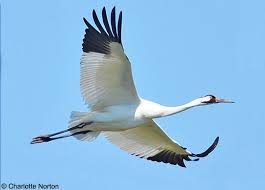
Iconic Whooping Cranes Making Way to Texas Coast
First Sightings Reported Near Rockport
AUSTIN – With the first sightings last week of iconic, endangered whooping cranes along the Texas coast, the Texas Parks and Wildlife Department is reminding Texans to be on the lookout for these impressive birds as they move through the state.
Whooping cranes face a harrowing, 2,500-mile journey from the breeding grounds in the marshy taiga of northern Alberta’s Wood Buffalo National Park to the coastal marshes of Texas each year. The migration south to Texas can take up to 50 days with the population typically traveling in small groups. Human-made structures like power lines, communication towers, and wind turbines pose significant threats, as do more natural perils like predators and harsh weather.
Along the way, whooping cranes seek out wetlands and agricultural fields to roost and feed in, and they often pass large urban centers like Dallas/Fort Worth, Waco, and Austin. Though they rarely stay in one place for more than a day during migration, it is essential that they not be disturbed or harassed at these stopovers. As a federally protected species, it is illegal to do so.
The Aransas National Wildlife Refuge first spotted the pair of the season October 22. Recent heavy rains brought much-needed fresh water to the area and should result in improved numbers of blue crabs and Carolina wolfberries, preferred whooper foods in coastal marshes.
The tallest bird in North America, the whooping crane, is also one of the rarest. With a current population of around 505 individuals, whooping cranes are slowly returning from the brink of extinction thanks to coordinated conservation efforts. Out of 87 nests, this summer only about 24 chicks fledged a low number compared to recent years, likely due to the unseasonably cold, wet weather.
The Aransas-Wood Buffalo population, the only “natural” flock of whooping cranes in the world, spends each winter in and around the Aransas National Wildlife Refuge near Rockport. However, with population expansion in recent years, they have begun spending time in more untraditional areas, venturing some distance from the refuge to find food and other resources.
“These iconic, endangered species deserve our respect as they migrate through the central flyway, and we ask the public to avoid disturbing them if spotted,” states Wade Harrell, U.S. Fish & Wildlife Service Whooping Crane Recovery Coordinator. “Along with whooping cranes migrating from Canada, Texas has had a few visiting whooping cranes from a reintroduced population in southwest Louisiana. These cranes are all marked with leg bands and Southeastern Texas, near Beaumont is where they were commonly spotted.”
With sandhill crane and waterfowl hunting seasons opening and whooper migration in full swing, TPWD urges hunters to be extra vigilant. Sometimes whooping cranes are found in mixed flocks with sandhill cranes, which are gray and slightly smaller. With their all-white body plumage and black wingtips, whooping cranes may also resemble snow geese, which are much smaller and have faster wing beats. Here’s a video detailing the differences between snow geese and whooping cranes.
Several other non-game species are similar in appearances such as wood storks, American white pelicans, great egrets, and others, but a close look will reveal reasonably differences. More information on look-alike species is available online.
The public can help track whooping cranes by reporting sightings to TPWD’s Whooper Watch, a citizen-science based reporting system to track whooping crane migration and wintering locations throughout Texas. More information about Whooper Watch, including instructions for reporting sightings, can be found online and by downloading the iNaturalist mobile app. These observations help biologists identify new migration and wintering locations and their associated habitats.

Big Time Texas Hunts Winners Announced
AUSTIN – The Texas Parks and Wildlife Department has announced the 14 lucky winners of this year’s Big Time Texas Hunts selected at random from entries in the drawing.
All told, hunters bought 94,705 Big Time Texas Hunt entries. They generated more than $871,644 in gross sales, and proceeds from the drawing go to support wildlife research, habitat management, and public hunting.
“We are extremely excited about the results this year. Not only that we can send 14 people and their friends/family on hunts of a lifetime, but through the generosity of hunters around the country we were able to raise important conservation dollars for wildlife habitat and public hunting projects on public lands in Texas,” said Justin Dreibelbis, TPWD Private Lands, and Public Hunting Program Director.
This year’s winner of the Texas Grand Slam hunting package, Greg May of Amarillo, is making plans for four separate guided hunts for the state’s top four premier big game species – desert bighorn sheep, white-tailed deer, pronghorn and mule deer.
Following are the other category winners of this year’s Big Time Texas Hunts:
Ultimate Mule Deer Hunt – Rod Rodriguez, Austin
Nilgai Antelope Safari – Craig McCallum, Rockwall
Premium Buck Hunt – Brooks Smith, Houston
Exotic Safari – Melvin Dennard, Friendswood
Whitetail Bonanza – Stewart Brandon, Sandia; Daniel Schuch, Leander; Thomas Becker, New Braunfels; Audion Hubenak, Rock Island; Thomas Riley, Granbury
Big Time Bird Hunt – Michael Ostrowski, Reading, PA
Gator Hunt – Mark Smith, Fort Worth
Texas Waterfowl Hunt – Dwight Volling, Alice
Wild Hog Adventure – Roland Krienke, Cedar Park
We notified all winners. Entries for next year’s Big Time Texas Hunts will go on sale May 15, 2019.
Big Time Texas Hunts is made possible with support from Toyota and the Texas Bighorn Society.








 EastTexasRadio.com Powered by Ten Stations
EastTexasRadio.com Powered by Ten Stations




